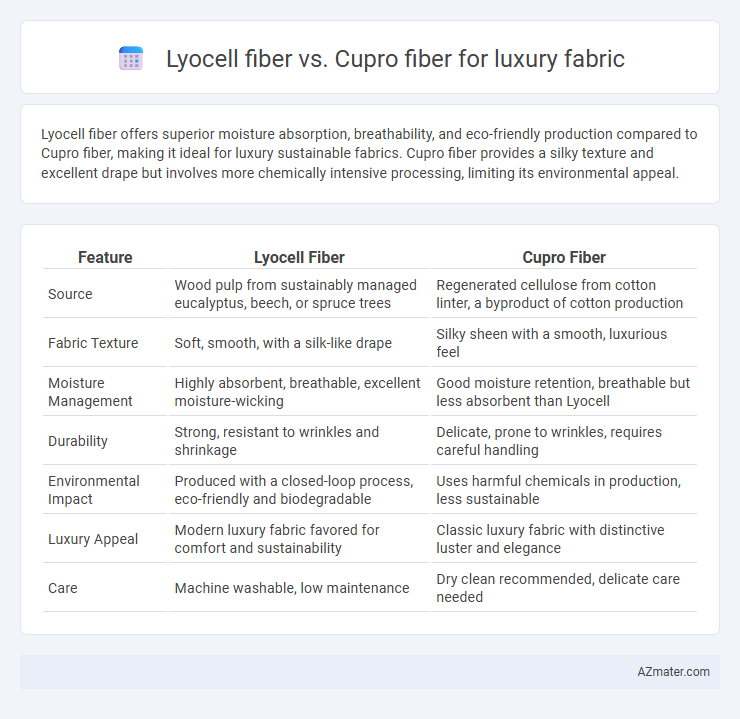Lyocell fiber offers superior moisture absorption, breathability, and eco-friendly production compared to Cupro fiber, making it ideal for luxury sustainable fabrics. Cupro fiber provides a silky texture and excellent drape but involves more chemically intensive processing, limiting its environmental appeal.
Table of Comparison
| Feature | Lyocell Fiber | Cupro Fiber |
|---|---|---|
| Source | Wood pulp from sustainably managed eucalyptus, beech, or spruce trees | Regenerated cellulose from cotton linter, a byproduct of cotton production |
| Fabric Texture | Soft, smooth, with a silk-like drape | Silky sheen with a smooth, luxurious feel |
| Moisture Management | Highly absorbent, breathable, excellent moisture-wicking | Good moisture retention, breathable but less absorbent than Lyocell |
| Durability | Strong, resistant to wrinkles and shrinkage | Delicate, prone to wrinkles, requires careful handling |
| Environmental Impact | Produced with a closed-loop process, eco-friendly and biodegradable | Uses harmful chemicals in production, less sustainable |
| Luxury Appeal | Modern luxury fabric favored for comfort and sustainability | Classic luxury fabric with distinctive luster and elegance |
| Care | Machine washable, low maintenance | Dry clean recommended, delicate care needed |
Introduction to Lyocell and Cupro Fibers
Lyocell fiber, derived from sustainably sourced wood pulp, is renowned for its strength, breathability, and eco-friendly production process using a closed-loop system that recycles solvents. Cupro fiber, a regenerated cellulose fabric made from cotton linter waste, offers a silky texture, excellent moisture absorption, and a luxurious sheen ideal for high-end garments. Both fibers serve as premium alternatives to traditional materials in luxury fabric applications due to their softness, durability, and sustainable origins.
Origins and Production Processes
Lyocell fiber originates from sustainably sourced eucalyptus wood pulp through a closed-loop solvent spinning process that recycles water and solvents, minimizing environmental impact. Cupro fiber is derived from cotton linter, the short fibers surrounding cotton seeds, using a chemical-intensive cuprammonium process that dissolves cellulose to create a silky fabric. Both fibers offer eco-conscious luxury options, with Lyocell prioritizing environmentally friendly production while Cupro involves more complex chemical treatments.
Environmental Impact and Sustainability
Lyocell fiber, derived from sustainably sourced wood pulp and produced through a closed-loop process, offers superior environmental benefits compared to Cupro fiber, which is regenerated from cotton linter using chemical-intensive methods. Lyocell's biodegradability and low water consumption make it a more sustainable choice for luxury fabrics, while Cupro's reliance on chemicals and higher energy use raises concerns about ecological footprint. Brands prioritizing eco-friendly luxury textiles increasingly prefer Lyocell for its responsible sourcing and minimal environmental impact.
Physical Properties and Texture
Lyocell fiber boasts exceptional moisture absorption, high tensile strength, and a smooth, silky texture that drapes elegantly, making it ideal for luxury fabric applications seeking durability and comfort. Cupro fiber, derived from regenerated cellulose, offers a lustrous sheen and a soft, breathable feel with moderate strength, prized for its silk-like texture and cooling properties in premium textiles. While Lyocell excels in wrinkle resistance and tensile durability, Cupro stands out for its smoothness and lustrous appearance, emphasizing a refined luxury tactile experience.
Comfort and Wearability
Lyocell fiber offers superior moisture-wicking and breathability, making it ideal for luxury fabrics that prioritize comfort and temperature regulation. Cupro fiber provides a silky smooth texture with excellent drape and softness, enhancing wearability for delicate, high-end garments. Both fibers are hypoallergenic and biodegradable, catering to sustainable luxury fashion demands.
Dyeing and Color Retention
Lyocell fiber exhibits excellent dye absorption and vibrant color retention due to its smooth surface and high moisture regain, ensuring deep, rich hues ideal for luxury fabrics. Cupro fiber, derived from regenerated cellulose, offers exceptional dye affinity with a silky texture that enhances color brightness and uniformity, making it popular for high-end fashion textiles. Both fibers maintain colorfastness well under repeated washing, but Lyocell's biodegradable nature and eco-friendly production process provide additional benefits for sustainable luxury fabric applications.
Luxury Appeal and Market Perception
Lyocell fiber is prized in luxury fabric for its exceptional softness, breathability, and eco-friendly renewable sourcing, appealing to consumers seeking sustainable high-end textiles. Cupro fiber, made from regenerated cotton linter, delivers a smooth, silk-like texture with a luxurious sheen that enhances garment drape and sophistication in premium collections. Market perception favors Lyocell for innovative sustainability credentials, while Cupro commands respect for its artisanal refinement and silk alternative qualities in luxury fashion.
Performance in High-End Fashion
Lyocell fiber offers superior moisture management and breathability, making it ideal for high-end fashion garments requiring comfort and durability. Cupro fiber excels in its silky texture and exceptional drape, providing luxury fabrics with an elegant sheen and smooth finish preferred in couture designs. Both fibers deliver eco-friendly benefits, but Lyocell's higher tensile strength supports long-lasting performance in luxury apparel.
Cost Considerations
Lyocell fiber generally offers a more cost-effective option for luxury fabrics due to its efficient closed-loop production process that reduces waste and energy consumption. Cupro fiber, derived from cotton linter, tends to be more expensive because of its intensive chemical processing and lower yield rates, which drive up manufacturing costs. Choosing between Lyocell and Cupro involves balancing material performance with cost efficiency, where Lyocell often provides a more budget-friendly yet sustainable luxury fabric alternative.
Final Verdict: Choosing Between Lyocell and Cupro
Lyocell fiber offers exceptional breathability, moisture-wicking properties, and sustainability, making it a preferred choice for luxury fabrics focused on comfort and eco-friendliness. Cupro fiber, derived from cotton waste, delivers a silky texture and superior drape with a natural sheen that enhances the aesthetic appeal of high-end garments. For discerning designers prioritizing eco-conscious innovation and durability, Lyocell is ideal, whereas Cupro excels in elegance and refined tactile experience for premium fashion pieces.

Infographic: Lyocell fiber vs Cupro fiber for Luxury fabric
 azmater.com
azmater.com